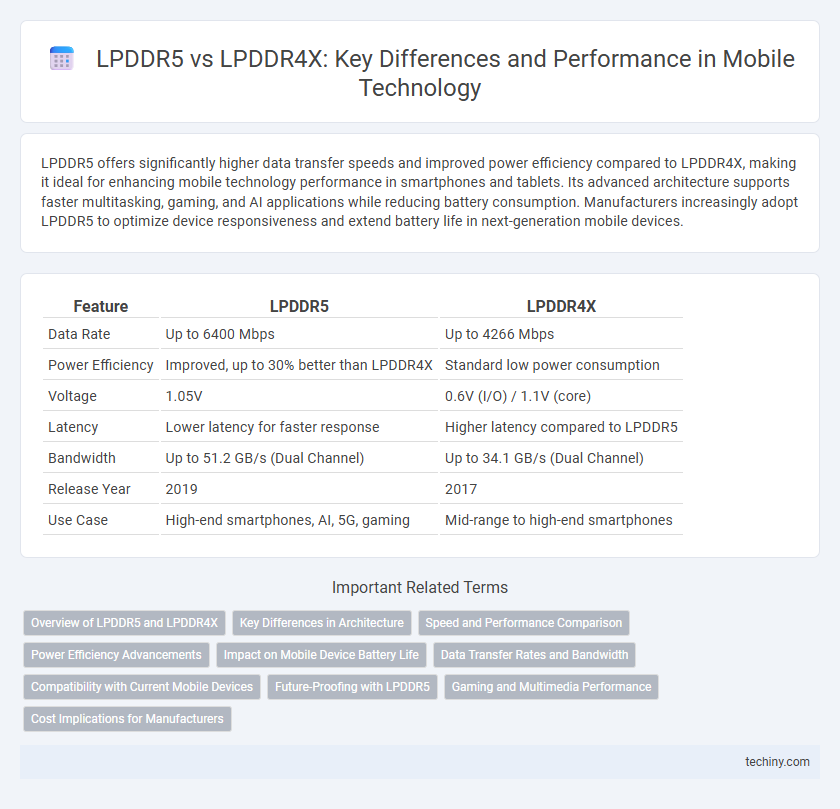LPDDR5 offers significantly higher data transfer speeds and improved power efficiency compared to LPDDR4X, making it ideal for enhancing mobile technology performance in smartphones and tablets. Its advanced architecture supports faster multitasking, gaming, and AI applications while reducing battery consumption. Manufacturers increasingly adopt LPDDR5 to optimize device responsiveness and extend battery life in next-generation mobile devices.
Table of Comparison
| Feature | LPDDR5 | LPDDR4X |
|---|---|---|
| Data Rate | Up to 6400 Mbps | Up to 4266 Mbps |
| Power Efficiency | Improved, up to 30% better than LPDDR4X | Standard low power consumption |
| Voltage | 1.05V | 0.6V (I/O) / 1.1V (core) |
| Latency | Lower latency for faster response | Higher latency compared to LPDDR5 |
| Bandwidth | Up to 51.2 GB/s (Dual Channel) | Up to 34.1 GB/s (Dual Channel) |
| Release Year | 2019 | 2017 |
| Use Case | High-end smartphones, AI, 5G, gaming | Mid-range to high-end smartphones |
Overview of LPDDR5 and LPDDR4X
LPDDR5 offers significant improvements over LPDDR4X with data rates up to 6400 Mbps compared to LPDDR4X's maximum of 4266 Mbps, enabling faster and more efficient mobile device performance. Enhanced power efficiency in LPDDR5 reduces energy consumption by implementing advanced power management features like deep sleep modes, which is critical for extending battery life in smartphones and tablets. Designed for high-bandwidth applications such as 5G connectivity and AI processing, LPDDR5 memory supports better multitasking and faster data transfer, making it the preferred choice for next-generation mobile technologies.
Key Differences in Architecture
LPDDR5 features an advanced architecture with higher data rates up to 6400 Mbps compared to LPDDR4X's maximum of 4266 Mbps, enabling faster memory access and improved power efficiency. LPDDR5 introduces dual-channel architecture and enhanced clocking mechanisms, reducing latency and boosting bandwidth for mobile devices. The optimized voltage scaling in LPDDR5 lowers power consumption, making it more suitable for high-performance smartphones and laptops compared to the older LPDDR4X standard.
Speed and Performance Comparison
LPDDR5 offers significantly higher data transfer rates up to 6400 Mbps compared to LPDDR4X's maximum of 4266 Mbps, resulting in faster memory access and enhanced multitasking capabilities. The improved efficiency of LPDDR5 reduces power consumption while maintaining superior throughput, which boosts overall mobile device performance. Enhanced bandwidth and lower latency in LPDDR5 enable smoother gaming, quicker app loading, and better support for AI workloads than LPDDR4X.
Power Efficiency Advancements
LPDDR5 delivers up to 30% lower power consumption compared to LPDDR4X by dynamically adjusting voltage and frequency based on workload demands. This advanced power management reduces energy use during standby and active states, significantly extending battery life in mobile devices. Enhanced signal integrity and data rates in LPDDR5 further optimize power efficiency without compromising performance.
Impact on Mobile Device Battery Life
LPDDR5 offers significantly improved power efficiency compared to LPDDR4X, reducing memory power consumption by up to 30%, which directly extends mobile device battery life. Enhanced data rates and lower operating voltage in LPDDR5 contribute to decreased energy usage during intensive tasks such as gaming and video streaming. Mobile devices equipped with LPDDR5 memory experience longer usage times and improved thermal management, translating into better overall battery performance and user experience.
Data Transfer Rates and Bandwidth
LPDDR5 delivers data transfer rates up to 6400 Mbps, significantly surpassing LPDDR4X which peaks at 4266 Mbps, enabling faster processing and reduced latency in mobile devices. The increased bandwidth of LPDDR5 enhances multitasking capabilities and supports advanced applications such as 5G connectivity and AI processing. With improved power efficiency and higher throughput, LPDDR5 is optimized for next-generation smartphones and tablets requiring accelerated data handling.
Compatibility with Current Mobile Devices
LPDDR5 offers improved speed and power efficiency but maintains backward compatibility with LPDDR4X interfaces, ensuring seamless integration in current mobile devices. Most modern smartphones and tablets can support LPDDR5 modules without major hardware modifications, facilitating smoother upgrades. This compatibility allows manufacturers to enhance device performance while leveraging existing infrastructure and reducing development costs.
Future-Proofing with LPDDR5
LPDDR5 offers significant advancements over LPDDR4X in terms of speed, power efficiency, and bandwidth, making it ideal for future-proofing mobile devices. With data rates up to 6400 Mbps, LPDDR5 supports next-generation applications like 8K video streaming, AI processing, and 5G connectivity more efficiently. Its enhanced power management features extend battery life, ensuring sustained performance for evolving mobile technology demands.
Gaming and Multimedia Performance
LPDDR5 offers significantly higher data transfer rates up to 6400 Mbps compared to LPDDR4X's maximum of 4266 Mbps, enhancing gaming experiences with faster load times and smoother frame rates. The improved power efficiency of LPDDR5 reduces battery consumption during intensive multimedia tasks, extending device usage for streaming and video playback. Advanced features in LPDDR5, such as improved reliability and lower latency, contribute to seamless multitasking and high-resolution graphics performance critical for mobile gaming and multimedia applications.
Cost Implications for Manufacturers
LPDDR5 offers enhanced speed and efficiency over LPDDR4X, but manufacturing costs increase due to more complex design and higher semiconductor process requirements. These cost implications affect product pricing strategies, particularly in mid-range to flagship mobile devices where performance gains justify the investment. Manufacturers must balance the higher cost of LPDDR5 with market demand for faster, more power-efficient mobile technology.
LPDDR5 vs LPDDR4X Infographic

 techiny.com
techiny.com